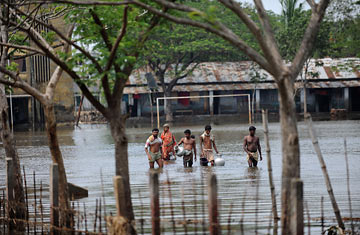
Bangladeshi villagers wade through floodwater after Cyclone Aila ravaged the region
Climate Change: The Anatomy of a Silent Crisis
The Global Humanitarian Forum; 117 pages
Download the PDF
The Gist:
Quick: What does global warming look like? A forlorn polar bear stuck on a splintering glacier makes for a gripping visual, but a new report says there are millions of climate-change victims we don't see — and many look just like us. The Global Humanitarian Forum paints a grim portrait of the human toll inflicted by Earth's gradual rise in temperature: 26 million people displaced, $125 billion in annual economic losses and more than 300,000 yearly deaths, as climate change speeds desertification and magnifies scourges from malnutrition to flooding. "We can no longer hold back from speaking out on the silent suffering of millions worldwide," writes the group's leader, former U.N. Secretary-General Kofi Annan.
(See the effects of climate change by 2020.)
Highlight Reel:
1. The scale of the problem: "Climate change is already seriously affecting hundreds of millions of people today and in the next 20 years those affected will likely more than double — making it the greatest emerging humanitarian challenge of our time ... The number of those severely affected by climate change is more than 10 times greater than, for instance, those injured in traffic accidents each year and more than the global annual number of new malaria cases. Within the next 20 years, 1 in 10 of the world's present population could be directly and seriously affected." (Watch an interview with Energy Secretary Steven Chu.)
2. Who endures the brunt of the crisis: "The first hit and worst affected by climate change are the world's poorest groups. Ninety-nine percent of all casualties occur in developing countries. A stark contrast to the one percent of global emissions attributable to some 50 of the least developed nations ... And the poor lack capacity to make their voices heard in international arenas or attract public and private investment. For those living on the brink of survival, climate change is a very real and dangerous hazard. For many, it is a final step of deprivation."
3. Observations from one "climate witness," a farmer in Kenya's Mara Basin: "When I was young, we used to have regular rains, but now it rains any time of the year. These changes started about 20 years ago. Food production in the area has gone down because people are not sure when to plant, and even when they plant, they may not get rains at the right time. Farming in our area is not only for our food, we depend on agriculture for income too. Some people have even had to resort to food donations from the government, something that has not happened since I was born." (See pictures of this fragile earth.)
The Lowdown:
The report admirably calls attention to the myriad hardships afflicting the world's poor, whose suffering too often escapes the gaze of the developed world. But the role of human-caused climate change in spawning the disasters is simply asserted more often than it's convincingly demonstrated. Critics have huffed that the report features more guesswork than science, ridiculing one calculation that factors in the frequency of earthquakes to determine global warming's impact on weather disasters (the authors do concede a "significant margin of error"). Specifics aside, the report is doubtless intended to haunt world leaders as they gather in Copenhagen later this year to negotiate a successor to the Kyoto Protocol. If its chilling claims are even partly true, the report should be read as a clarion call to action.
Verdict: Skim.
